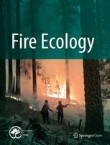Fire Ecology is the official journal of the Association for Fire Ecology.
Correction to: Fuels, vegetation, and prescribed fire dynamics influence ash production and characteristics in a diverse landscape under active pine barrens restoration
Following publication of the original article Quigley et al. 2019, the authors reported that an incorrect version of Additional 1 has been published. The corrected version of Additional file 1 is attached to t...
